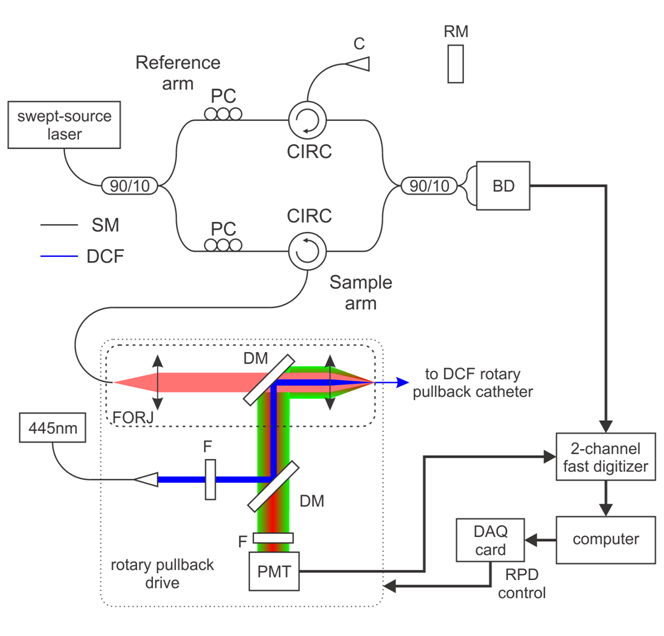Dual modality OCT-AFI
Both optical coherence tomography (OCT) and autofluorescence imaging (AFI) have shown potential for cancer detection. OCT is able to measure epithelial thickness and identify micro invasion through the basement membrane. AFI in the lung and oral cavity is used clinically to identify abnormal tissue and guide biopsy site selection. Recently, we demonstrated the ability of catheter-based AFI to identify vascular networks in small peripheral airways.
Catheter
Fiber-optic catheters fabricated with double-clad fiber (DCF) instead of single-mode (SM) fiber have enabled endoscope-compatible OCT-AFI for dual-modality imaging. The design is similar to our OCT catheter (described here) but employs the inner-cladding of the DCF to provide an additional fiber channel for efficient collection and transmission of the AFI signal.

The core of the DCF is used for guiding OCT light while the inner cladding is employed to carry the autofluorescence signal. The large inner-cladding diameter of the DCF results in high AFI collection efficiency and the common-path configuration for the two modalities ensures co-registration. The fiber-optic subassembly is fabricated by fusion splicing short lengths of precision-cut optical fiber to the end of the DCF fiber. As shown above, we begin with step-index multi-mode (MM) fiber, followed by graded-index (GRIN) fiber to provide the focusing power, and finally no-core fiber (NCF). The NCF is ground down at >45 degrees and polished to make at side-looking probe with Doppler sensitivity.
The fiber-optic subassembly is encapsulated in epoxy and a double-wound cable is attached for torque transmission. The optical core rotates and pulls back in a stationary plastic tube. As illustrated below, the optical core sweeps out a helical scan to provide 3-D volumetric OCT, and in addition, we get a 2-D cylindrical surface map of airway autofluorescence.

Instrumentation
The instrumentation is composed two imaging subsystems. The optical pathways of the OCT and AFI subsystems are merged between the collimators of a fiber-optic rotary joint (FORJ) prior to coupling into the DCF. The OCT interferometer with dual-balanced detection and polarization diversification is identical that described previously.



















